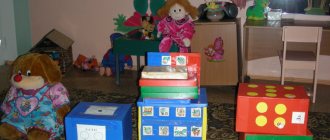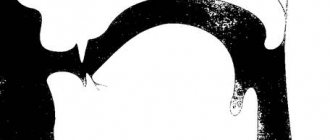How to teach children to identify the properties and characteristics of objects?
Khudyakova Elena Vyacheslavovna teacher MBOU "Aganskaya OSSH" preschool groups. Agan, Nizhnevartovsk district
The material was sent for publication in the All-Russian printed collection of practice-oriented materials “Preschool and primary education - modern methods and technologies of teaching and upbringing” - OCTOBER 2021.
HOW TO TEACH CHILDREN TO IDENTIFY THE PROPERTIES AND SIGNS OF OBJECTS?
- Abstract: The article discusses the following questions: how to gradually teach children to identify the properties and characteristics of objects.
- Key words: attribute of an object, property of an object
- Thematic heading: preschool education.
What is an item?
Advertising message
An object is all kinds of things around us, living beings, animals, plants, natural phenomena.
Each object has characteristics that distinguish it from another object.
Objects differ in color, shape, size, purpose, material from which they are made and other characteristics.
To determine the attribute of an object, you can ask the following questions:
- - Which?
- - which?
- -which?
- - which?
A sign is the presence or absence of a property in an object, as well as the presence or absence of a relationship between objects.
The attribute of an object is the way in which objects are similar to each other or how they differ from each other.
In everyday life, we teach our children to determine the properties of objects all the time, without noticing it. We ask, discuss and talk with the child (what color the object is, what shape it is, etc.).
So, let's try to highlight the essential features using the example of a lemon. Show your child this object (picture). Ask him to describe it, asking him questions; if the child finds it difficult, help him. What colour is he? “What shape?”, “What does it taste like?”, “What does it feel like?” Lemon: yellow, oval, sour, hard.
We teach children to identify the characteristics of an object by shape
Ask your child what shapes objects come in? (oval, round, square, rectangular).
You can offer your child, name and show objects of round, oval, square and rectangular shape. Or ask what figure the object resembles.
We teach children to identify the characteristics of an object by color
You can offer the child, name and show objects of red, yellow, green, etc. colors.
Ask your child what is green and what is blue? etc.
Thus, teaching a child to identify essential features by comparison should be done in stages:
- stage: Identify features or properties of one object.
- stage: Identify signs or properties of two objects
- stage: Identify signs or properties of three or more signs.
There are a lot of games and exercises for developing techniques for identifying features of an object. Let's look at a few of these games.
- Game "Guess who it is?"
Goal: development of an active vocabulary of adjectives denoting color, size, and qualitative characteristics of animals.
Progress of the game: an adult names several words (it is advisable to use mostly adjectives) describing this or that animal. The child’s task is to guess who they are talking about as quickly as possible.
More general descriptions should be given first. Then name more precise signs that are characteristic only of the hidden creature.
For example:
- Gray, angry, toothy, hungry. (wolf)
- Small, gray, cowardly, long-eared. (hare)
- Small, short-legged, hardworking, prickly. (hedgehog)
- Game "What is round?"
Here, of course, everyone knows what things are like here.
Purpose: To clarify children’s ideas about the size of objects; learn to classify objects according to a certain criterion (size, color, shape); develop quick thinking.
Progress of the game. Tossing the ball to children in various ways, the teacher asks a question to which the child, having caught the ball, must answer and then return the ball to the teacher. The teacher, in turn, passes the ball to the next child, waiting for an answer from him.
- What is round? (Ball, ball, wheel, sun, moon, apple, cherry...)
- What is long? (Road, river, rope, thread, tape, cord...)
- What is high? (Mountain, tree, man, hundred, house, closet...)
- What is green? (Grass, trees, bushes, grasshoppers, dress...)
- What happens when it's cold? (Water, snow, ice, dew, frost stone, night...)
- What is smooth? (Glass, mirror, stone, apple...)
- What's sweet? (Sugar, sweets, pies, cakes, waffles...)
- What is wool? (Dress, sweater, mittens, gloves, hat...)
- What is prickly? (Hedgehog, rose, cactus, needles, spruce wire...)
- What is spicy? (Knife, awl, glass, scissors, dagger, blade...)
- What's easy? (Fluff, feather, cotton wool, snowflake).
- What is deep? (Ditch, ditch, ravine, well, river, stream...)
3. Game “What dish is this?”
Goal: formation of relative adjectives in children’s speech.
- What soup made from... (beans, peas, fish, chicken, beets, mushrooms, vegetables)?
- What porridge is made from... (millet, rolled oats, semolina, buckwheat...)?
- What kind of jam is made from... (apples, plums, apricots, raspberries...)?
- What juice from... (carrots, pears, oranges...)?
- What kind of dishes are... (glass, metal, ceramic, porcelain, clay, plastic)? Give examples. Why is it called that? (glass - made of glass.)
- 4. Game “Name which one...”
Goal: formation of relative adjectives in children’s speech.
- The cabinet is made of wood, which means it is wooden.
- The bed is made of iron,…
- The sofa is made of leather,…
- The chair is made of plastic,…
Game "Say Otherwise"
Goal: expanding the dictionary of antonyms.
- Not sad children - ... (cheerful.)
- Not cold water - ... (warm.)
- Not a long rain - ... (short.)
- Not a dark sky - ... (light.)
- Not a rainy sky - ... (sunny.)
- Not bitter raspberries - ... (sweet.)
- Not low grass - ... (high.)
5. Game “Pick a sign”
Goal: agreement of adjectives with nouns.
- Doll (what?) - ..., ball (what?) - ...;
- Snow (what?) - ..., frost (what?) - ..., Icicle (what?) - ..., winter (what?);
- Summer (what?) – warm, bright, colorful, hot.
- The sun (what?) is yellow, hot, bright, warm.
- The grass in summer (what?) is green, fragrant, tall, short, soft.
- The water in summer (what?) is warm, cool, pleasant, refreshing.
- Rain in summer (what kind?) – warm, long-awaited, torrential, short, lingering.
- Children in the summer (what?) are cheerful, joyful, funny, tanned.
- The sky in summer (what?) is blue, bright, light, cloudless, stormy.
You can see the table of authors and learn more about the collections HERE
Summary of a correctional speech therapy lesson on the topic: “Words denoting a feature of an object”
Author-compiler: Speech therapist Ashmarina Irina Nikolaevna
Goal: to form a concept of words denoting a feature of an object.
Tasks:
Educational:
- to develop in children the ability to coordinate an adjective with a noun;
-enrich vocabulary.
Educational:
- develop coherent speech;
-develop visual-spatial coordination.
Educational:
- cultivate perseverance and attention.
Material and technical equipment: pictures on the topic, notebooks, pens, pencils, task cards.
Progress of the lesson:
Emotional-setting moment (emotional inclusion)
The speech therapist asks students what date, day of the week, month it is.
Corrective stage
Articulation gymnastics (depending on what sound or letter we are going through during the lesson) “Smile”, “Delicious jam”, “Shovel”, “Horse”.
Activity stage.
The speech therapist asks questions to the students:
- What is the weather today? (Frosty)
- Why frosty? (we see light patterns on the windows)
—What day is it like when the sun is shining? (Solar.)
- And when there is no wind? (Windless.)
Speech therapist: Let’s find out what day it is today. (The day is frosty, sunny, windless.)
How can we say about the weather, does it have the same symptoms? (The weather is frosty, sunny, windless.)
Development of visual-spatial coordination.
Speech therapist: Guys, please draw a Christmas tree in the lower right corner of the sheet.
Let's select words-signs for it. What Christmas tree? (green, fluffy, small).
Speech therapist: Please draw a cloud in the upper left corner.
Match the words that match the cloud. What is it like? (white, soft, light).
Speech therapist: Draw a sun in the center of the sheet. What sun? (yellow, warm, bright, beautiful).
Fizminutka:
We repeat all the warm-up movements without hesitation! Hey! They jumped on the spot. Eh! We wave our hands together. Ehe - heh! They bent their backs and looked at the shoes. Hey - hey! Bent down lower. Bent closer to the floor. Turn around in place deftly. We need skill in this. What did you like, my friend? Tomorrow there will be another lesson!
Development of phonemic hearing and phonemic awareness
Speech therapist: Listen to a series of words and name from this series words that denote the attribute of an object: sun, earth, warm, spruce, green, yellow, soft, sky, high, snow, fluffy.
Enrichment of the grammatical structure of speech.
Read the words. Connect words with opposite meanings with lines.
Working with cards.
| Hardworking | Kind |
| wicked | silent |
| talkative | lazy |
| soft | brave |
| cowardly | hard |
Emotional-reflective stage (evaluative).
- Today we got acquainted with the words that mean? – What did you find most difficult in the lesson? — Rate yourself and your mood (emoticons)
Share on social media networks
To My World
0
Tweet
RќСЂР°РІРёС‚СЃСЏ
I advise you to read more on this topic
- Lexico-grammatical exercises and speech games on the topic “Clothing”
- Norms for child speech development at 3 years old
- Games for the development of memory and speech in preschoolers. Part 1. Game “Remember the pictures”
- Summary of a speech therapy lesson for children with special needs on the topic “Transport”
- Using fables as a means of developing coherent speech in older children

